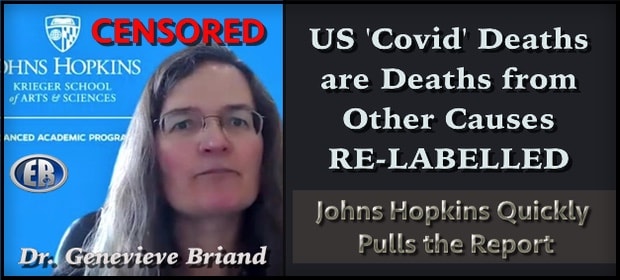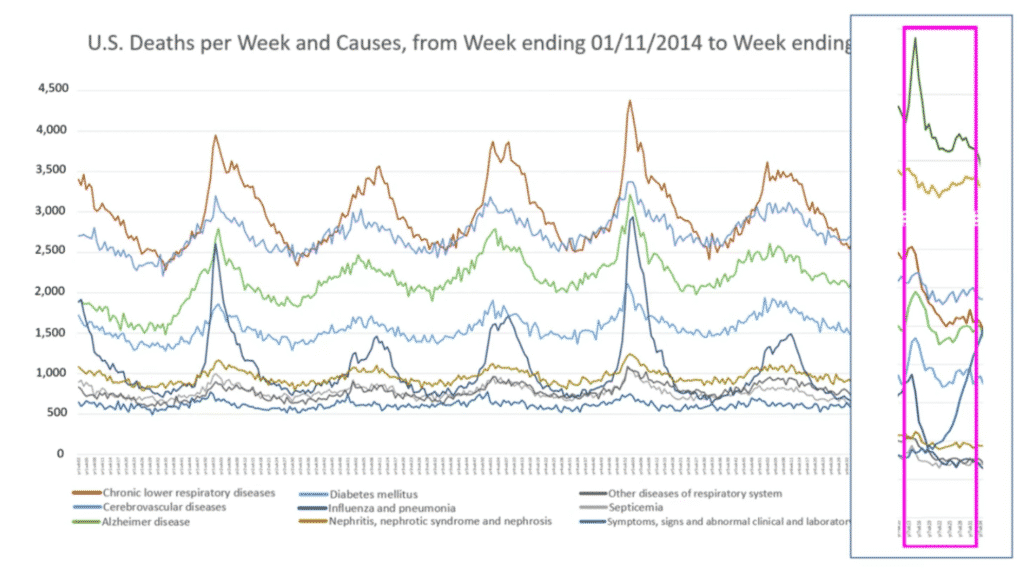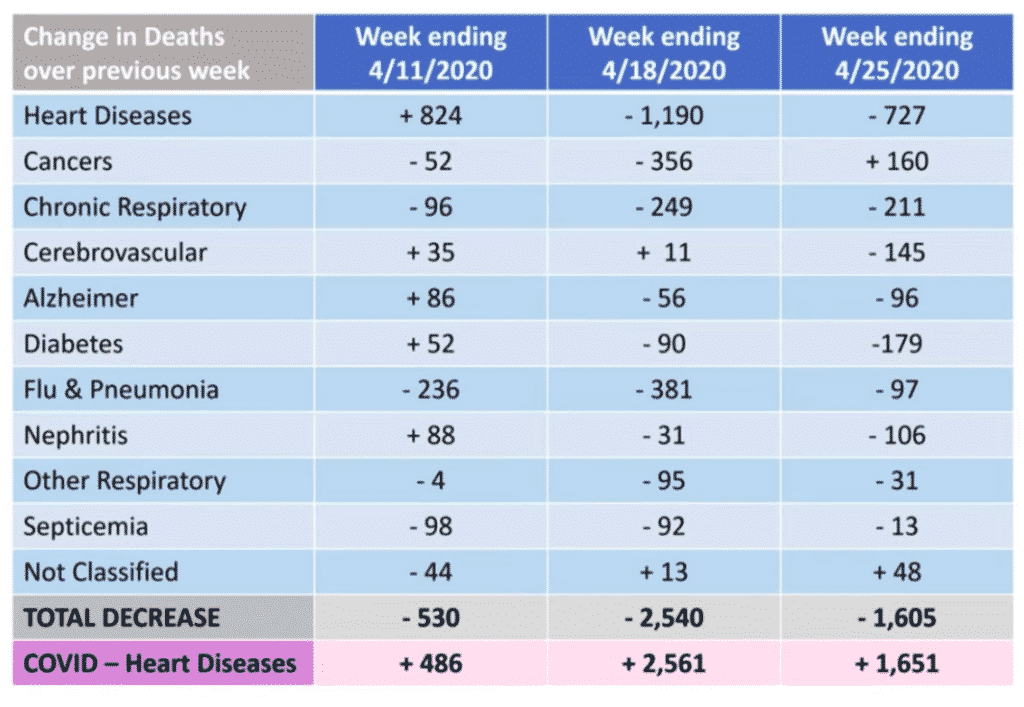
Yanni Gu, a student at JHU, wrote an article summarizing these findings and noted that patients dying from other diseases who also tested positive for COVID-19 are classified as COVID-19 deaths. The Johns Hopkins News-Letter, a student newspaper, retracted Yanni Gu’s article because it was contrary to information coming from the CDC and the WHO and, therefore, it was false. Furthermore, Briand is an economist, not a medical professional. -GEG
In a separate article, independent researcher Earl Wyatt (ER: See Do the numbers justify the response?) found that it was nearly impossible to find the total number of deaths in the United States in 2020 beyond March. The data is being withheld. He wrote that he found a source that had numbers for state-by-state deaths at IndexMundi.com that does show total deaths for so far in 2020. Using those numbers he found that the total death rate from all causes is going down, not up. Clearly, there is no deadly pandemic underway. Wyatt wrote, “Any number less than an almost 10 percent increase from year to year indicates just how little coronavirus actually affected the nation, but it may have a significant effect on how we view the role of government in our lives and our dependence on elected officials.” -GEG

Johns Hopkins: U.S. Death Rate Remains Normal Despite COVID-19
TECHNOCRACY NEWS
Johns Hopkins published a devastating expose of hysterical pandemic exaggeration, which was dramatically “un-published” shortly thereafter. Why? Because it crushed the global narrative that COVID is driving up overall death numbers. It is not!
The study was performed by Professor Genevieve Briand, PhD, who is the Assistant Director of the MS program in Applied Economics at Johns Hopkins. As an economist looking at readily available data, her analysis is indisputable.
Technocrats who drive the global pandemic hysteria claim to be pro-science and based on the Scientific Method, but as a group, they are skilled manipulators who lie with statistics with intent to deceive the public. We hope that Dr. Briand will not be summarily fired for exposing this fraud. ⁃ TN Editor
****

YANNI GU via JOHN HOPKINS NEWS LETTER
According to new data, the U.S. currently ranks first in total COVID-19 cases, new cases per day and deaths. Genevieve Briand, assistant program director of the Applied Economics master’s degree program at Hopkins, critically analyzed the effect of COVID-19 on U.S. deaths using data from the Centers for Disease Control and Prevention (CDC) in her webinar titled “COVID-19 Deaths: A Look at U.S. Data.”
From mid-March to mid-September, U.S. total deaths have reached 1.7 million, of which 200,000, or 12% of total deaths, are COVID-19-related. Instead of looking directly at COVID-19 deaths, Briand focused on total deaths per age group and per cause of death in the U.S. and used this information to shed light on the effects of COVID-19.
She explained that the significance of COVID-19 on U.S. deaths can be fully understood only through comparison to the number of total deaths in the United States.
After retrieving data on the CDC website, Briand compiled a graph representing percentages of total deaths per age category from early February to early September, which includes the period from before COVID-19 was detected in the U.S. to after infection rates soared.
Surprisingly, the deaths of older people stayed the same before and after COVID-19. Since COVID-19 mainly affects the elderly, experts expected an increase in the percentage of deaths in older age groups. However, this increase is not seen from the CDC data. In fact, the percentages of deaths among all age groups remain relatively the same.
“The reason we have a higher number of reported COVID-19 deaths among older individuals than younger individuals is simply because every day in the U.S. older individuals die in higher numbers than younger individuals,” Briand said.
Briand also noted that 50,000 to 70,000 deaths are seen both before and after COVID-19, indicating that this number of deaths was normal long before COVID-19 emerged. Therefore, according to Briand, not only has COVID-19 had no effect on the percentage of deaths of older people, but it has also not increased the total number of deaths.
These data analyses suggest that in contrast to most people’s assumptions, the number of deaths by COVID-19 is not alarming. In fact, it has relatively no effect on deaths in the United States.
This comes as a shock to many people. How is it that the data lie so far from our perception?
To answer that question, Briand shifted her focus to the deaths per causes ranging from 2014 to 2020. There is a sudden increase in deaths in 2020 due to COVID-19. This is no surprise because COVID-19 emerged in the U.S. in early 2020, and thus COVID-19-related deaths increased drastically afterward.
Analysis of deaths per cause in 2018 revealed that the pattern of seasonal increase in the total number of deaths is a result of the rise in deaths by all causes, with the top three being heart disease, respiratory diseases, influenza and pneumonia.
“This is true every year. Every year in the U.S. when we observe the seasonal ups and downs, we have an increase of deaths due to all causes,” Briand pointed out.
When Briand looked at the 2020 data during that seasonal period, COVID-19-related deaths exceeded deaths from heart diseases. This was highly unusual since heart disease has always prevailed as the leading cause of deaths. However, when taking a closer look at the death numbers, she noted something strange. As Briand compared the number of deaths per cause during that period in 2020 to 2018, she noticed that instead of the expected drastic increase across all causes, there was a significant decrease in deaths due to heart disease. Even more surprising, as seen in the graph below, this sudden decline in deaths is observed for all other causes.

COURTESY OF GENEVIEVE BRIAND Graph depicts the number of deaths per cause during that period in 2020 to 2018.
This trend is completely contrary to the pattern observed in all previous years. Interestingly, as depicted in the table below, the total decrease in deaths by other causes almost exactly equals the increase in deaths by COVID-19. This suggests, according to Briand, that the COVID-19 death toll is misleading. Briand believes that deaths due to heart diseases, respiratory diseases, influenza and pneumonia may instead be recategorized as being due to COVID-19.

COURTESY OF GENEVIEVE BRIAND
Graph depicts the total decrease in deaths by various causes, including COVID-19.
The CDC classified all deaths that are related to COVID-19 simply as COVID-19 deaths. Even patients dying from other underlying diseases but are infected with COVID-19 count as COVID-19 deaths. This is likely the main explanation as to why COVID-19 deaths drastically increased while deaths by all other diseases experienced a significant decrease.
“All of this points to no evidence that COVID-19 created any excess deaths. Total death numbers are not above normal death numbers. We found no evidence to the contrary,” Briand concluded.
In an interview with The News-Letter, Briand addressed the question of whether COVID-19 deaths can be called misleading since the infection might have exacerbated and even led to deaths by other underlying diseases.
“If [the COVID-19 death toll] was not misleading at all, what we should have observed is an increased number of heart attacks and increased COVID-19 numbers. But a decreased number of heart attacks and all the other death causes doesn’t give us a choice but to point to some misclassification,” Briand replied.
In other words, the effect of COVID-19 on deaths in the U.S. is considered problematic only when it increases the total number of deaths or the true death burden by a significant amount, in addition to the expected deaths by other causes. Since the crude number of total deaths by all causes before and after COVID-19 has stayed the same, one can hardly say, in Briand’s view, that COVID-19 deaths are concerning.
Briand also mentioned that more research and data are needed to truly decipher the effect of COVID-19 on deaths in the United States.
Throughout the talk, Briand constantly emphasized that although COVID-19 is a serious national and global problem, she also stressed that society should never lose focus of the bigger picture — death in general.
The death of a loved one, from COVID-19 or from other causes, is always tragic, Briand explained. Each life is equally important and we should be reminded that even during a global pandemic we should not forget about the tragic loss of lives from other causes.
According to Briand, the over-exaggeration of the COVID-19 death number may be due to the constant emphasis on COVID-19-related deaths and the habitual overlooking of deaths by other natural causes in society.
During an interview with The News-Letter after the event, Poorna Dharmasena, a master’s candidate in Applied Economics, expressed his opinion about Briand’s concluding remarks.
“At the end of the day, it’s still a deadly virus. And over-exaggeration or not, to a certain degree, is irrelevant,” Dharmasena said. (ER: This is puzzling. First, we’ve just been shown how it ISN’T a deadly virus. And second, why are we being graced with the opinion of a ‘master’s candidate’, i.e. someone who so far only has a bachelors’ degree to his name? Well, Yanni Gu is a student, which perhaps explains the lack of rigor.)
When asked whether the public should be informed about this exaggeration in death numbers, Dharmasena stated that people have a right to know the truth. However, COVID-19 should still continuously be treated as a deadly disease to safeguard the vulnerable population.
************
Source

••••
The Liberty Beacon Project is now expanding at a near exponential rate, and for this we are grateful and excited! But we must also be practical. For 7 years we have not asked for any donations, and have built this project with our own funds as we grew. We are now experiencing ever increasing growing pains due to the large number of websites and projects we represent. So we have just installed donation buttons on our websites and ask that you consider this when you visit them. Nothing is too small. We thank you for all your support and your considerations … (TLB)
••••
Comment Policy: As a privately owned web site, we reserve the right to remove comments that contain spam, advertising, vulgarity, threats of violence, racism, or personal/abusive attacks on other users. This also applies to trolling, the use of more than one alias, or just intentional mischief. Enforcement of this policy is at the discretion of this websites administrators. Repeat offenders may be blocked or permanently banned without prior warning.
••••
Disclaimer: TLB websites contain copyrighted material the use of which has not always been specifically authorized by the copyright owner. We are making such material available to our readers under the provisions of “fair use” in an effort to advance a better understanding of political, health, economic and social issues. The material on this site is distributed without profit to those who have expressed a prior interest in receiving it for research and educational purposes. If you wish to use copyrighted material for purposes other than “fair use” you must request permission from the copyright owner.
••••
Disclaimer: The information and opinions shared are for informational purposes only including, but not limited to, text, graphics, images and other material are not intended as medical advice or instruction. Nothing mentioned is intended to be a substitute for professional medical advice, diagnosis or treatment.




